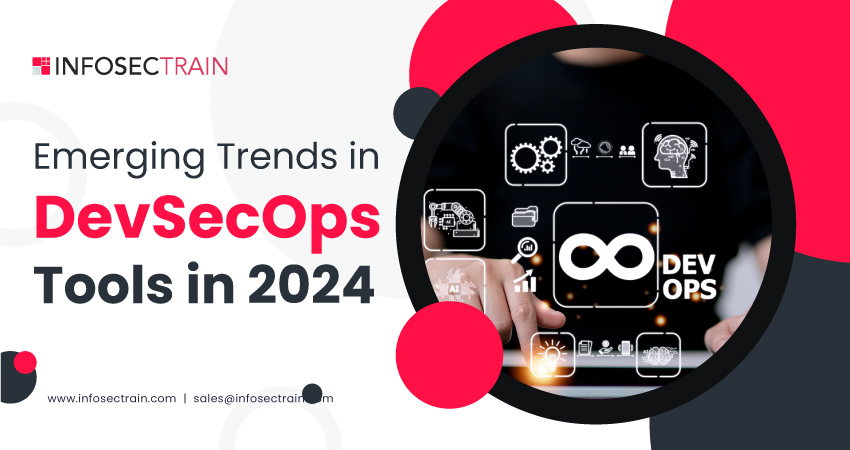Emerging Trends in DevSecOps Tools in 2024
In 2024, the ever-changing realm of software development demands staying ahead of the curve. DevSecOps, the amalgamation of Development, security, and operations, reshapes how organizations approach software delivery. This shift brings a surge of cutting-edge tools that redefine the DevSecOps landscape. Notably, integrating automation, AI, and a proactive security mindset emerges as a hallmark of progress. Organizations must actively embrace these trends as necessary, not just a choice, to deliver innovative and inherently secure software.

What is DevSecOps?
DevSecOps is like a teamwork approach to ensure computer programs are safe and secure. It combines Development (making the program), Security (keeping it safe), and Operations (running the program). The idea is to include security from the beginning of making a program instead of adding it later. DevSecOps encourages teams to work together and talk to each other to find and fix security problems early on. This way, they are proactive about security, use automation to make things easier, and follow the best ways to keep programs safe. The goal is to create programs that are not just safe but also strong and reliable.
Emerging Trends in DevSecOps Tools in 2024
1. Integration of Security Into CI/CD Pipelines:
Organizations actively incorporate security into their CI/CD pipelines, ensuring continuous security checks and tests during Development. This integration plays a crucial role in preventing the deployment of security vulnerabilities to production. By embedding security measures into the CI/CD process, organizations enhance the overall security of their software development lifecycle. This proactive approach minimizes the risk of deploying flawed code and strengthens the security posture of the production environment.
2. Increased Adoption of Cloud-Native Security Tools:
Organizations are fully embracing cloud-native security tools as they move more workloads to the cloud. These tools, designed specifically for cloud environments, offer heightened visibility and control over security risks. The increasing adoption of these tools reflects a commitment to securing assets in the cloud. By utilizing cloud-native security solutions, organizations enhance their ability to manage and mitigate potential security threats associated with their cloud-based operations.
3. Increased Collaboration Between Security And Development Teams:
Organizations are promoting collaboration between security and development teams, dismantling traditional silos. This collaborative approach establishes a culture of shared responsibility for security, aiming to enhance the overall security posture. Breaking down barriers between these teams is a strategic effort to mitigate the risk of security breaches. By working together, security and development teams contribute to an environment that prioritizes and strengthens security measures.
4. Automation of Vulnerability Scanning and Remediation:
Organizations automate vulnerability scanning and remediation to identify and address security issues early in Development. Mitigating the risk of security breaches and enhancing the overall security posture crucially involves introducing automation. By automating these processes, organizations streamline identifying and resolving security vulnerabilities, contributing to a more secure software development lifecycle. The proactive nature of automation ensures that potential threats are addressed efficiently, reducing the likelihood of security incidents.
5. Rise Of Security-as-Code (SaC) Tools:
Security-as-code (SaC) tools are reshaping how security integrates into the SDLC. These tools empower developers to articulate security requirements in code, enabling automatic enforcement throughout Development. The rise of SaC tools signifies a shift in how security is managed, emphasizing a proactive and code-driven approach. By allowing security to be defined in code, these tools contribute to seamlessly integrating security measures in the development lifecycle.
6. Application of ML and AI in the Field of Security:
Organizations leverage machine learning and AI to detect and prioritize security risks, automate tasks, and enhance the efficiency of security teams. These technologies are pivotal in automating security procedures and improving the efficacy of security measures. Organizations streamline identifying and prioritizing security threats by utilizing machine learning and AI. This proactive approach enhances overall security protocols by enabling security teams to respond more efficiently to potential risks.
Some Examples of Emerging DevSecOps Tools
1. Snyk: Snyk, a cloud-native security platform, offers visibility and control over security risks within cloud environments. The platform actively provides organizations with the tools to manage and mitigate security threats in the cloud. Snyk prioritizes strengthening security protocols, ensuring a proactive strategy to recognize and address possible threats. This platform is designed to empower organizations with comprehensive security solutions tailored for cloud environments.
2. GitLab Security: GitLab Security comprises integrated security tools within the GitLab DevOps platform. The tools actively enhance the security measures embedded in the GitLab platform. Organizations benefit from a seamless integration of security features, ensuring a comprehensive approach to safeguarding their DevOps processes. GitLab Security is designed to fortify the security posture of projects managed within the GitLab DevOps environment.
3. Veracode: Veracode, a static application security testing (SAST) tool, scans source code to pinpoint potential vulnerabilities. This tool actively analyzes code, providing insights into potential security risks. Organizations benefit from Veracode’s capability to identify and address security vulnerabilities in the early stages of application development. It bolsters software security by proactively detecting and addressing potential threats.
4. Pulumi: Pulumi is an infrastructure-as-code (IaC) tool that allows developers to articulate security requirements directly in code. This tool empowers developers to define and manage infrastructure elements using code-based specifications. With Pulumi, developers can seamlessly integrate security measures into the infrastructure provisioning process. The platform facilitates a code-driven approach for specifying and enforcing security in infrastructure development.
5. CloudBees Flow: CloudBees Flow, a CI/CD platform, actively integrates security measures into the development process. This platform is designed to seamlessly incorporate security considerations throughout the continuous integration and continuous delivery lifecycle. Organizations benefit from the automated inclusion of security practices, ensuring a robust and secure software development pipeline. CloudBees Flow enhances the overall efficiency and safety of the development process by actively integrating security into its core functionalities.
DevSecOps Engineer Course with InfosecTrain?
InfosecTrain, a leading IT security training and consulting services provider, delivers tailored and cost-effective training globally for businesses and individuals. We design role-specific certification programs like the Certified DevSecOps Engineer (E|CDE) course to prepare professionals for the future by instilling DevSecOps principles. This training empowers participants with essential skills to create, implement, and maintain secure applications and infrastructure. Invest in your career with our flexible and comprehensive DevSecOps Engineer program, supported at every stage by our unwavering commitment to helping you thrive in the ever-evolving DevSecOps landscape.




 1800-843-7890 (India)
1800-843-7890 (India) 
